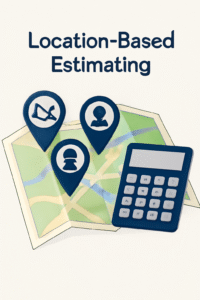Unlock the secrets to location-based cost estimating and how to accurately calculate project costs based on geographic factors. Learn the top 7 essential considerations for construction projects.
Introduction: Understanding the Power of Location-Based Cost Estimating
In the world of construction, estimating costs accurately is essential to ensure a project is completed within budget. One method that has become increasingly important in modern construction is location-based cost estimating. This approach takes into account the geographical variables that can impact the overall cost of a construction project. From labor rates to transportation costs, location-based estimating provides more precision than traditional methods, helping businesses make informed decisions and streamline project management.
This blog will dive into the seven key factors that make location-based cost estimating an indispensable tool for the construction industry, offering actionable insights to improve the accuracy and effectiveness of your cost estimates.
What is Location-Based Cost Estimating?
Location-based cost estimating is a methodology that factors in regional variables when calculating the costs of a construction project. Unlike traditional cost estimating techniques, which primarily focus on material costs and labor rates without considering geographic differences, location-based estimating integrates the specific conditions of a region. These conditions could include:
-
Local labor rates
-
Material availability
-
Transportation costs
-
Geographic obstacles
-
Climate considerations
-
Regulatory environment
By incorporating these factors, location-based estimating provides a more tailored and accurate cost prediction, helping to avoid cost overruns and delays in construction projects.

1. Regional Labor Rates: A Crucial Factor
Labor costs can vary significantly depending on the location of the project. In urban areas, for example, labor rates may be higher due to the demand for skilled workers and the higher cost of living. Conversely, rural locations may offer lower labor rates but could come with other challenges like a shortage of skilled workers. By factoring in regional labor rates, you ensure that your cost estimates are aligned with the realities of the job market in your project’s location.
Tip: Always reference local wage surveys or industry data to gain an accurate picture of labor costs in your area.
2. Material Costs and Availability
Material costs can also fluctuate depending on the location. In some areas, construction materials may be more expensive due to transportation costs, while in others, they may be less expensive due to proximity to suppliers or production facilities. Location-based estimating allows for better tracking of material availability, ensuring that the project is not delayed by shortages or price hikes.
Example: For a project in a remote area, material transportation costs can significantly increase the overall price of the project. Location-based estimating will help account for these costs in advance.
3. Transportation and Logistics
The distance from suppliers to the project site plays a key role in estimating costs. Delivery fees for materials, fuel costs, and the time spent on transportation can add up quickly, especially when dealing with heavy or bulky materials. A project in a congested city will have its own set of transportation challenges, such as dealing with traffic or limited access for large trucks, while a rural project may face higher logistics costs due to the need for longer travel distances.
Tip: Factor in local transportation constraints to avoid any surprises in the project budget. Construction projects in large cities may have hidden costs associated with transportation delays or road permits.
4. Geographic and Environmental Conditions
The geography of a location plays a significant role in shaping construction costs. For example, building on a hill or in a floodplain can require additional foundation work, drainage solutions, or environmental remediation. These additional tasks could raise the cost of the project and impact the project timeline. With location-based estimating, you can factor in the unique characteristics of the land where the construction will take place.
Example: In a coastal area, building foundations might require deeper pilings to prevent water damage from rising sea levels, increasing the project’s cost.
5. Climate and Weather Considerations
Weather can have a direct effect on construction costs and timelines. A region that experiences heavy rainfall, snow, or extreme temperatures may require more expensive materials or specialized labor, and may also experience longer downtime due to adverse weather conditions. By considering the local climate, construction managers can anticipate delays and cost adjustments, leading to more accurate budgeting.
Tip: Consider building schedules that take weather delays into account. In colder climates, for instance, concrete work might need to be scheduled during warmer months to avoid freezing issues.
6. Local Regulatory and Building Codes
Every region has its own set of regulations, building codes, and zoning laws. These rules govern everything from the types of materials that can be used to the height and design of a building. Failing to account for these regulations can result in costly fines or delays if changes are required to meet local building codes. Location-based estimating allows project managers to account for these requirements upfront.
Example: A construction project in a densely populated city will likely face stricter zoning laws and building codes, leading to higher compliance costs compared to a more rural area.
7. Market Demand and Competition
Finally, location-based estimating considers the level of competition and market demand for construction services in a specific area. In areas where construction activity is high, such as metropolitan regions or rapidly growing cities, labor and material costs may rise due to increased demand. On the other hand, a market with lower demand for construction services might offer more competitive prices but could also suffer from delays or a lack of skilled workers.
Tip: Always assess the competitive landscape in your area. If you’re in a highly competitive region, costs may be higher, but opportunities for faster project completion may also arise due to the abundance of available labor.
Why Location-Based Estimating Matters for Your Business
-
Improved Accuracy: By incorporating location-specific data, location-based estimating allows for more precise cost predictions, reducing the risk of cost overruns and budget surprises.
-
Better Decision-Making: Knowing the full scope of costs associated with the geographical location of your project helps make better purchasing and planning decisions.
-
Competitive Advantage: Construction companies that use location-based estimating can offer more realistic bids and avoid costly surprises, which helps them stay competitive in the market.
How to Implement Location-Based Cost Estimating
To effectively implement location-based cost estimating, consider the following steps:
-
Research Local Data: Collect data on labor rates, material prices, transportation costs, and other region-specific factors.
-
Use Software Tools: Leverage construction estimating software that supports location-based cost estimating, allowing you to input geographical variables into your cost calculations.
-
Collaborate with Local Experts: Work with local contractors, suppliers, and consultants to gain a better understanding of regional pricing and logistics.
-
Review Historical Data: Look at past projects in the same or similar locations to identify trends and refine your estimates.
Conclusion: A Smarter Way to Estimate Construction Costs
In an industry where precision is paramount, location-based cost estimating offers a powerful way to improve the accuracy of construction cost predictions. By factoring in the unique characteristics of each region—labor, materials, transportation, climate, regulations, and competition—construction professionals can create more reliable budgets and avoid unexpected expenses.
Zion Estimating Services Inc. specializes in helping contractors and developers create location-based estimates that align with regional demands, ensuring that projects are completed on time and within budget.
Call to Action:
Ready to take your cost estimating to the next level? Contact Zion Estimating Services Inc. today to learn how we can help you create accurate, location-based cost estimates for your next project. Call us at 718-427-9941 or email [email protected] for more details.
